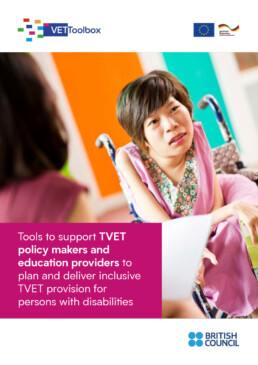Tools to support TVET policy makers and education providers to plan and deliver inclusive TVET provision for persons with disabilities
What is this tool about?
The World Health Organization (WHO) and the World Bank estimate the global disability prevalence at 15 per cent of a population. Approximately 80 per cent of them are of working age. The prevalence is higher for women and girls with disabilities at 19 per cent compared to men and boys with disabilities with 12 per cent. According to the WHO and the World Bank, 20 per cent of women and girls with disabilities in low-income countries are employed, compared to 59 per cent of their male peers. These rates are consistently lower than for persons without disabilities.
It is essential to recognise that persons with disabilities are not a homogenous group. Persons with intellectual impairments, persons with hearing impairments, persons with visual impairments, persons with physical impairments, and persons with multiple impairments do not share the same abilities, disabilities and needs. Even within one group of impairments, the abilities, disabilities, and needs differ, depending on the individuals and their environments. In a nutshell: there is no one-size-fits-all approach for TVET and labour market inclusion.
This tool aims at guiding policy makers and TVET college staff to improve the inclusiveness of TVET.
Tool 1 concerns the policy level and aims at policy makers who intend to access the national TVET framework and get practical hints about how to improve inclusiveness for persons with disabilities.
Tool 2 aims at TVET college staff. It introduces the concept of the “disability support unit”. The role of the unit is to advise and support TVET instructors, caregivers of learners with disabilities and students with disabilities. The tool also features a comprehensive set of indicators for physical accessibility. The final chapters are about human resource considerations and accessible complain mechanisms.
Would you like to know more?
Download the full guide for free on this page or send us an email to info@vettoolbox.eu.





